Almost 5,000 hotel keys have been added to Qatar’s stock over the past 18 months and the additional supply has started to impact performance measures in the second quarter of 2016, a DTZ executive says.
Occupancy levels fell 64% in April 2016 compared to 72% in the same month in 2015, while average daily rates also experienced a year-on-year (y-o-y) fall of 6.5% from QR551 in April 2015 to QR515 in April 2016, said DTZ associate director – Consulting and Research Johnny Archer.
Speaking before stakeholders yesterday at the launching of DTZ’s “Q2 2016 Qatar Market Report,” Archer said revenue per available room fell by 17.8% from QR399 in April 2015 to QR328 in April 2016.
“This definitely is a challenge in the hospitality market over the next few years in terms of trying to maintain and increase occupancy levels and performance measures,” Archer noted.
Citing official figures from the Qatar Tourism Authority (QTA), Archer said the supply of hotel accommodation in Qatar surpassed 20,700 by the start of 2016.
According to the DTZ report, Doha has currently 123 hotel and hotel apartment establishments. Of the current supply, approximately 88% is categorised as either 4-Star or 5-Star.
“This trend is likely to continue in the short term as 85% of upcoming establishments in the development pipeline fall within these high-end categories, although 30% of the development pipeline has yet to be classified,” it said.
QTA figures revealed that the number of tourist arrivals showed a 3.7% y-o-y increase in 2015. But despite growing tourist numbers, DTZ said overall hotel occupancy rates in the hospitality sector declined by 2% to 71% in 2015, largely due to the increase in the supply over this period.
Citing figures from the Ministry of Development Planning and Statistics in April 2016, the report said occupancy rates for the month fell by 8% to 64% from the corresponding month in 2015. Based on QTA statistics, the report said 56 hotels and 13 hotel apartment buildings, with a total of 26,653 rooms, are currently under construction and due to be released within the next five years.
In the retail market, Archer said no new malls have opened since Gulf Mall in early 2015. He also said retail spending went down “between 10% and 15%” since the second quarter of 2015 due to “less confidence” from investors following the oil price drop and the number of workers that left Qatar in the past year.
But rental levels “remained largely unchained” in the second quarter of 2016, he said, adding that “prime malls typically command between QR260/sq m and QR300/sq m per month for the standard line units, while larger stores can secure rents of between QR170/sq m and QR220/sq m per month.
“After a strong uptake of pre-lease agreements in the main upcoming malls, DTZ understands that Q2 has seen activity slow down due to uncertainty and premium rents sought. Rental levels for the high-profile malls being constructed carry a significant premium over existing malls, with rents of QR400+ quoted for line units,” he said.

DTZ associate director u2013 consulting and research Johnny Archer says revenue per available room fell by 17.8% from QR399 in April 2015 to QR328 in April 2016. PICTURE: Shaji Kayamkulam



